 |
Old Bull Lee A Voice From the Reality-based Community Notes from a Study of Things Themselves |
 |
Michael Hastings' Last Ride
Michael Hastings, a 33-year old investigative journalist, died June 18, 2013 at about 4 am in a fiery car crash in Los Angeles. Witnesses said Hastings' Mercedes coupe, traveling at a speed of perhaps 100 mph, ran a red light, veered onto a grassy median strip, plowed into a palm tree and exploded in flames. The collision was so violent that the Mercedes engine and transmission broke loose from the car frame, flew into the oncoming lane of traffic and came to rest 125 feet from the crash. .
There's suspicion that Hastings' death was the result of sabotage. It's been theorized that electronic subsystems in his vehicle were hacked such that he was unable to control his car's throttle. As a result, he found himself trapped inside his car as it accelerated to high speed and crashed into a tree, killing him in a violent collision and fire. It's also suspected that the hacking employed an incendiary explosive to ensure that the wreck not only killed Hastings but also destroyed evidence of tampering.
If you're unfamiliar with Michael Hastings or the reasons his wreck was suspicious, then Crashes of Convenience - Corbett Report #274, a 42-minute documentary video, is recommended viewing. If you're skeptical that automobile electronics can be hacked, I suggest a 2010 paper by researchers at the University of Washington and the University of California at San Diego.
The LAPD has declared there was no foul play in the incident, so it's unlikely there will ever be an investigation into the possibility of sabotage. If there is, it will be overseen by the FBI, the US government's secret political police. This fact guarantees any investigation will be a sham. That's because the FBI and other covert agencies, including the NSA, CIA and JSOC, are the only parties with both the motivation and the means to sabotage Michael Hastings' car. These parties will never find themselves responsible for the death of Michael Hastings. Their public statements should not be trusted.
Related Posting: The Michael Hasting Police Report - A Critical Examination
Our purpose here is to reconstruct the events of the morning of June 18 using only material that is uncontaminated by possibly corrupt police and FBI investigations. This material includes credible eyewitness accounts, videos captured shortly before and after the crash and publicly available maps and images. So first, we state what we know for sure. Then we examine the supporting evidence. Then we discuss some unanswered questions.
The Crash Event: What Really Happened
The map below shows the area of LA where Hastings spent his last moments. The terrain is flat and streets intersect at right angles. Hastings is known to have traveled south on North Highland Avenue from the intersection at Santa Monica Boulevard to the midpoint between Melrose Avenue and Clinton Street. The distance between those two points is about 3000 feet, or 0.57 miles.
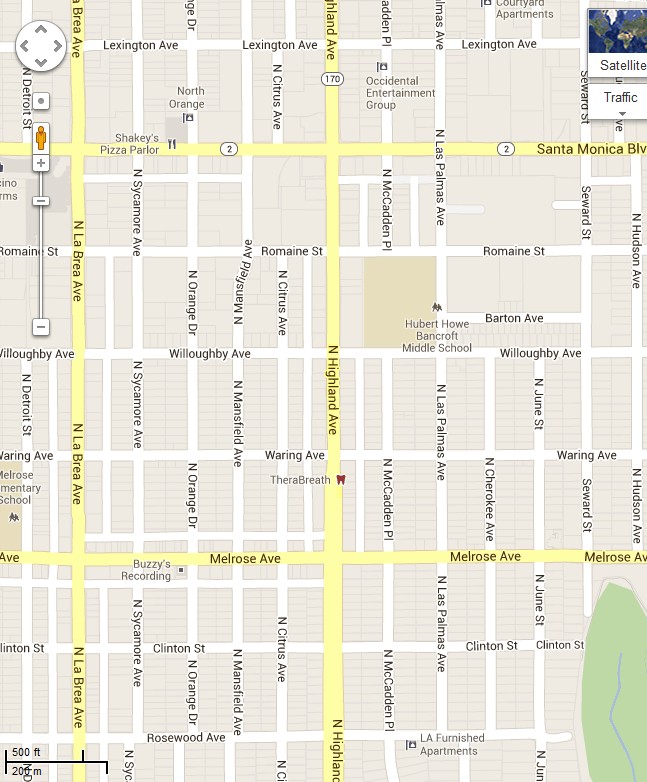
1. Michael Hastings, in a 2013 Mercedes C250 coupe traveling south on North Highland Avenue, Los Angeles, California at about 4:15 am on June 18, 2013, ran the red light at Santa Monica Boulevard at a speed of 79 mph. His vehicle continued south at high speed, crossing intersections at Romaine, Willoughby and Waring.
2. At Melrose Avenue he again ran a red light at high speed. Because of a slight hump in the center of Melrose and his high speed, his car went airborne and came down hard as he entered the 600 block of North Highland. A witness said sparks and flames were underneath his vehicle at this time.
3. He appeared to lose control of his car and veered off the pavement onto a grassy median strip.
4. In the median he struck a water-pipe fixture about two feet tall. He sheared off these pipes, leaving water gushing four feet in the air.
5. About twenty feet beyond the water pipes, he crashed into a tall palm tree in the middle of the block. Impact point on the automobile was directly in front of the driver.
6. The vehicle was immediately engulfed in flames. Witnesses said it seemed to explode. The explosion seems to be confirmed by a video recording from a nearby security camera.
7. Collision debris, including the engine/transmission assembly, was strewn into the northbound lane of North Highland. The pattern and location of the debris suggest that car parts (1) came loose from the vehicle because of structural damage caused by the wreck and (2) flew forward because of momentum resulting from the high speed of the vehicle at the instant the parts broke loose.
8. Firemen arrived on the scene within five minutes of the crash. They extinguished the fire but left Hastings in the car. Policemen and detectives photographed and videotaped the accident scene but didn't disturb it. At 7:20 am two coroners, with the help of firemen, removed Hastings body from the wreck. A witness was surprised to see that only Hastings' head appeared burned. The rest of his body was unburned and intact.
Hastings' car, a 2013 Mercedes C250 coupe, was similar to the one below.

Evidence: The LoudLabs Videos
LoudLabs is a Los Angeles company that employs freelance videographers to capture video from late night events. L. A. Weekly says they:
work the night shift in L.A. because local TV stations don't budget enough for expensive, three-person news vans to work overnight. The freelance crews listen to police scanners and sell their footage to the stations.
LoudLabs has posted several videos from the Hastings wreck at Youtube. Two of them are discussed below. I call them the dashcam video and the handheld camera video.
Dashcam video. This includes footage of the Hastings car immediately after it's run a red light at the intersection of Santa Monica and North Highland. In the Youtube commentary associated with the video, LoudLabs uses the length of the car, its extent in individual frames (measured in pixels) and the frame rate of the camera to compute Hastings speed. Their estimate: 79 mph.
What we see here is 24:30 minutes of video recorded by a Loudlabs camera attached to the dashboard of a Loudlabs vehicle as it traveled around LA, mainly Hollywood, about 4 in the morning of June 18.
0:23 - Beginning of the real "unedited" dashcam recording. The Loudlabs vehicle is on the north side of Santa Monica Boulevard, facing south, at the intersection with North Gardner Street, about 13 blocks west of North Highland Avenue. The vehicle pulls into Santa Monica Boulevard and heads east.
3:55 - LoudLabs vehicle pulls into Mobil station at the southwest corner of the Santa Monica/North Highland intersection. It parks parks there, facing east, with the dashcam still recording.
5:47 - Michael Hastings' car (blurred in this single frame) is seen passing in front of the camera, traveling south on North Highland.
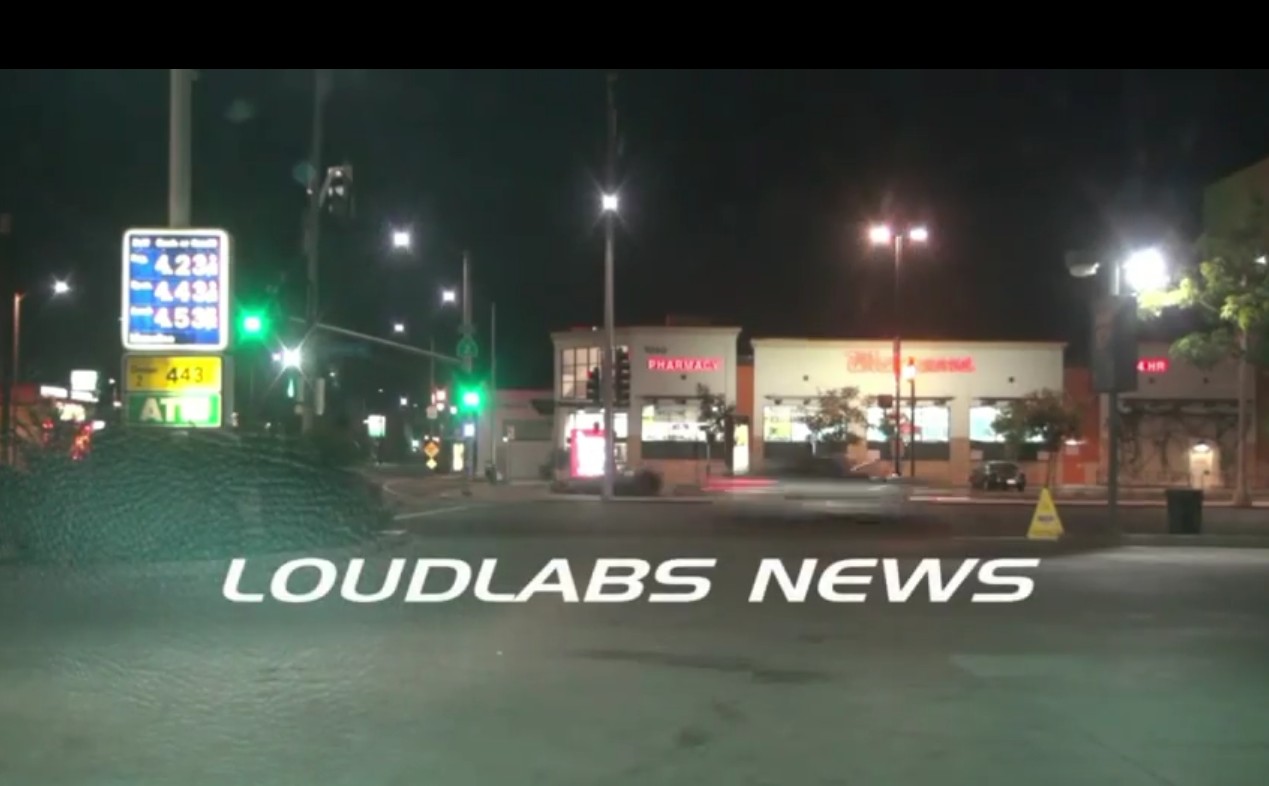
7:10 - The LoudLabs vehicle pulls out of the Mobil station and heads east on Santa Monica.
8:17 - The Loudlabs vehicle gets audio instructions to go to Melrose/North Highland. The driver turns south, winds through residential streets and eventually comes back to North Highland, where he turns left to go south.
10:03 - The dashcam vehicle reaches the Melrose/North Highland intersection. The Hastings car is in the grassy median, fully engulfed in flames. Water is gushing out of the ground nearby. (Also see the gushing water several times in the handheld camera video.) A man is spraying water on the burning car with a garden hose but it isn't having any effect. Note: If Michael Hastings averaged 79 mph down North Highland, then this is about 3:50 after the crash.
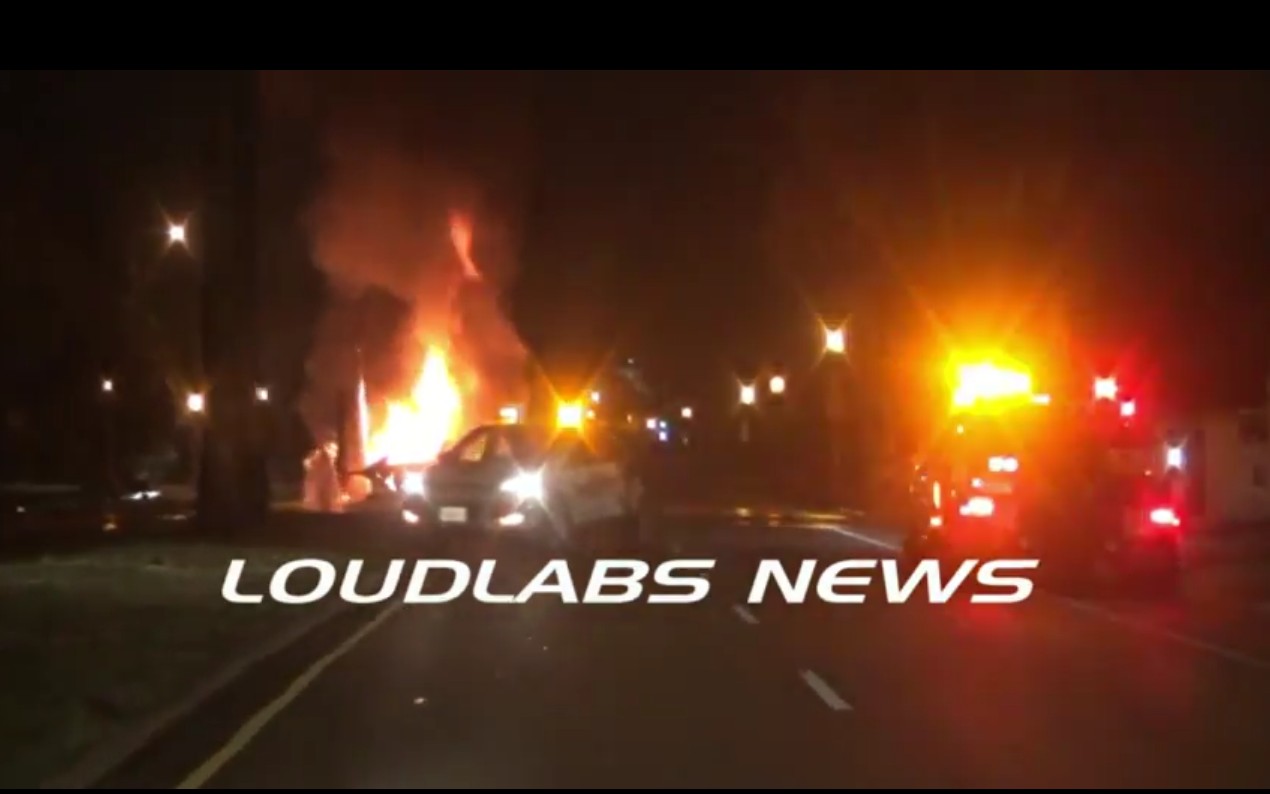
10:30 - LoudLabs vehicle pulls over to the side of the street and parks, leaving the dashcam running for the next 14 minutes, but there's not much of interest to see. Evidently, the LoudLabs driver got out of his vehicle at that point and began recording video using a different (handheld) camera.
Handheld camera video. The first 25 seconds were seen earlier in the dashcam video. Original stuff begins at 0:25 as the videographer roams around the crash scene.
1:10 - Off-camera voices: "On impact it blew up?" "Yep."
3:00 - Eyewitness with "ALSCO" and "Jose" on his uniform describes the crash in broken English. Says the wrecked car was going "Fast, fast."
4:48 - Debris in the northbound lane of North Highland. The debris is all south of the wreck.
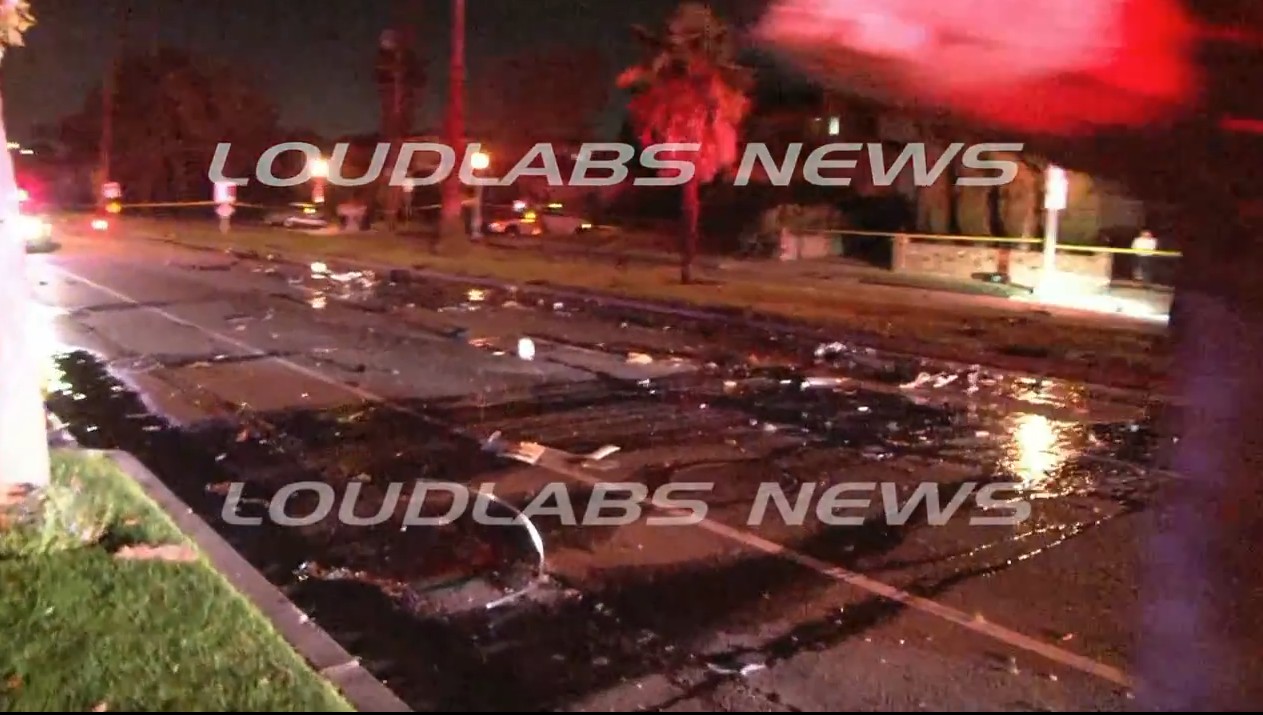
5:03 - Looking north. Engine and transmission in northbound lane of North Highland at Clinton Street. Note the two leaning trees.
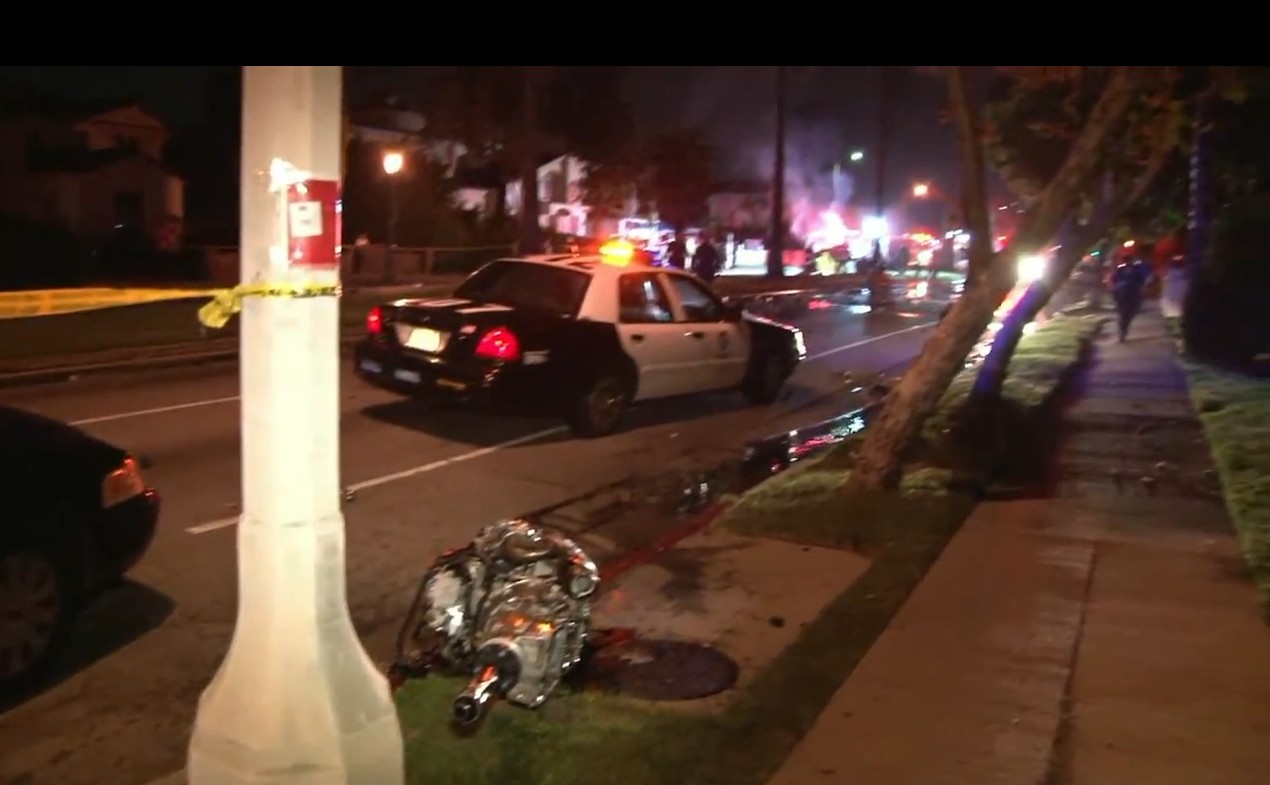
From the LoudLabs videos and from Google Street View and Satellite View we can determine exactly where Hastings' car struck the tree in the 600 block of North Highland.
Here's how the 600 block of North Highland appears in daylight if you're heading south, as Michael Hastings was. At the extreme right in this image is Mozza Pizzeria, where a security camera recorded the crash.
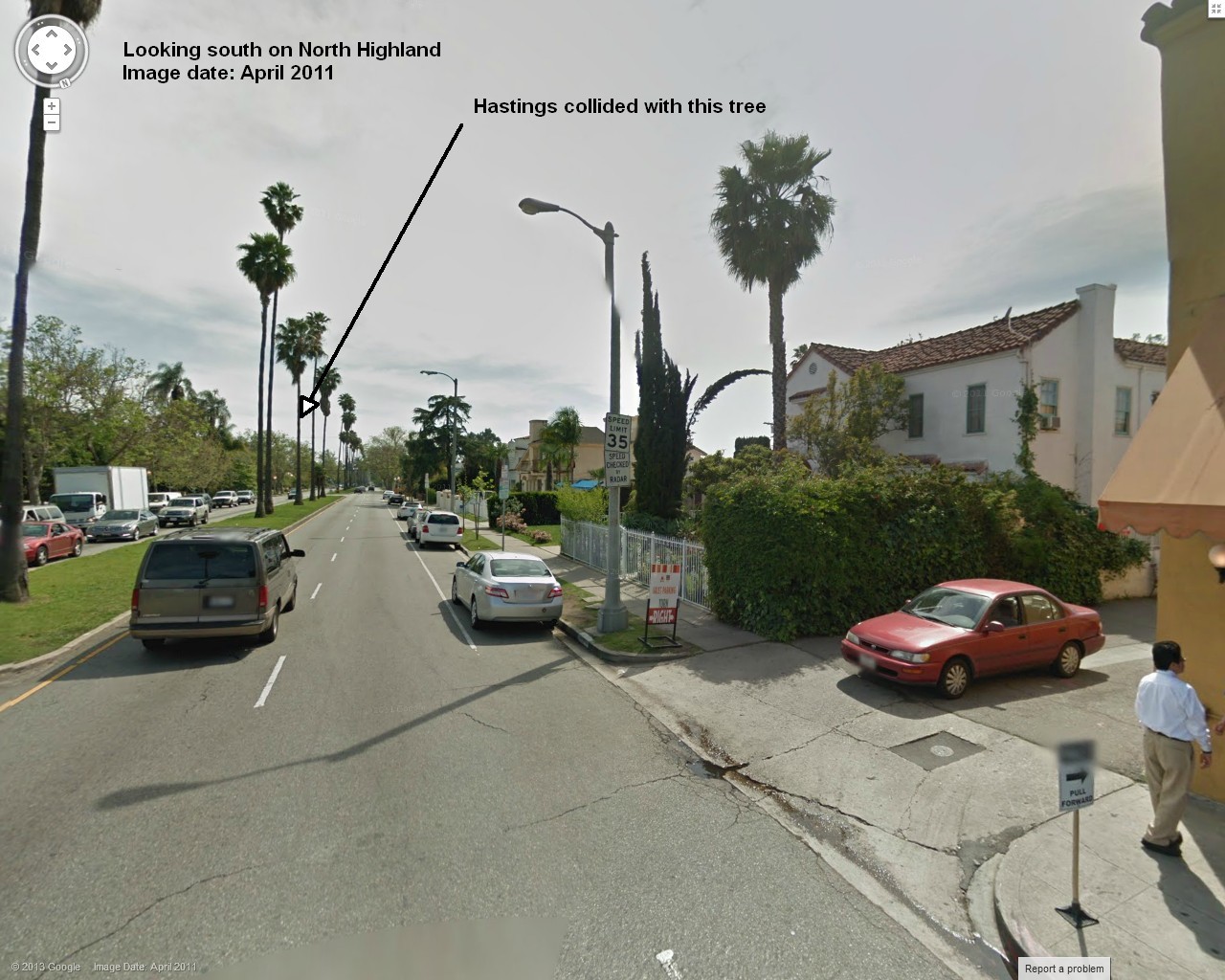
Here's the same block seen from Clinton Street, looking north. Note the two leaning trees, which are the same as the leaning trees in the image (above) of the engine/transmission in the street.

Evidence: Pizzeria Mozza Security Camera Video
Pizzeria Mozza is at the southwest corner of the North Highland/Melrose intersection. One of its security cameras caught the Hastings crash and a 27-second clip has been posted on Youtube.
At 0:15 Michael Hastings' car comes into the field of view. It appears to veer left into the median, explode in two flashes of light and burn until the end of the recording.
Michael Krikorian, a friend of the Mozza Pizzeria owner, recounts how he came upon the crash scene and thought of examining the restaurant's security camera recording. He examines the frames showing Michael Hastings' car moving though the field of view and gets comments from others.
He writes:
Highland has a very slight rise and fall at its intersection with Melrose. It's difficult to tell by the film, but based on tire marks--which were not brake skid marks, by the way--chalked by the traffic investigators, it seems that the Mercedes may have been airborne briefly as it crossed the intersection, then landed hard. Tire marks were left about 10 feet east of the restaurant's valet stand.
(Later, I drove the intersection at just 45 mph, and my car rose up significantly.)
About 100 feet after the car zooms by on the tape, it starts to swerve. At about 195 feet from the camera, the car jumps the curb of the center median, heading toward a palm tree 56 feet away.
About halfway between the curb and the tree, the car hits a metal protrusion--perhaps 30 inches tall and 2 feet wide--that gives access to city water mains below. This is where the first small flash occurs. This pipe may have damaged the undercarriage of the car, perhaps rupturing a fuel line.
The "slight rise and fall" of Melrose Avenue can be seen in this Google street view image. That hump appears to have caused Hastings' loss of control.
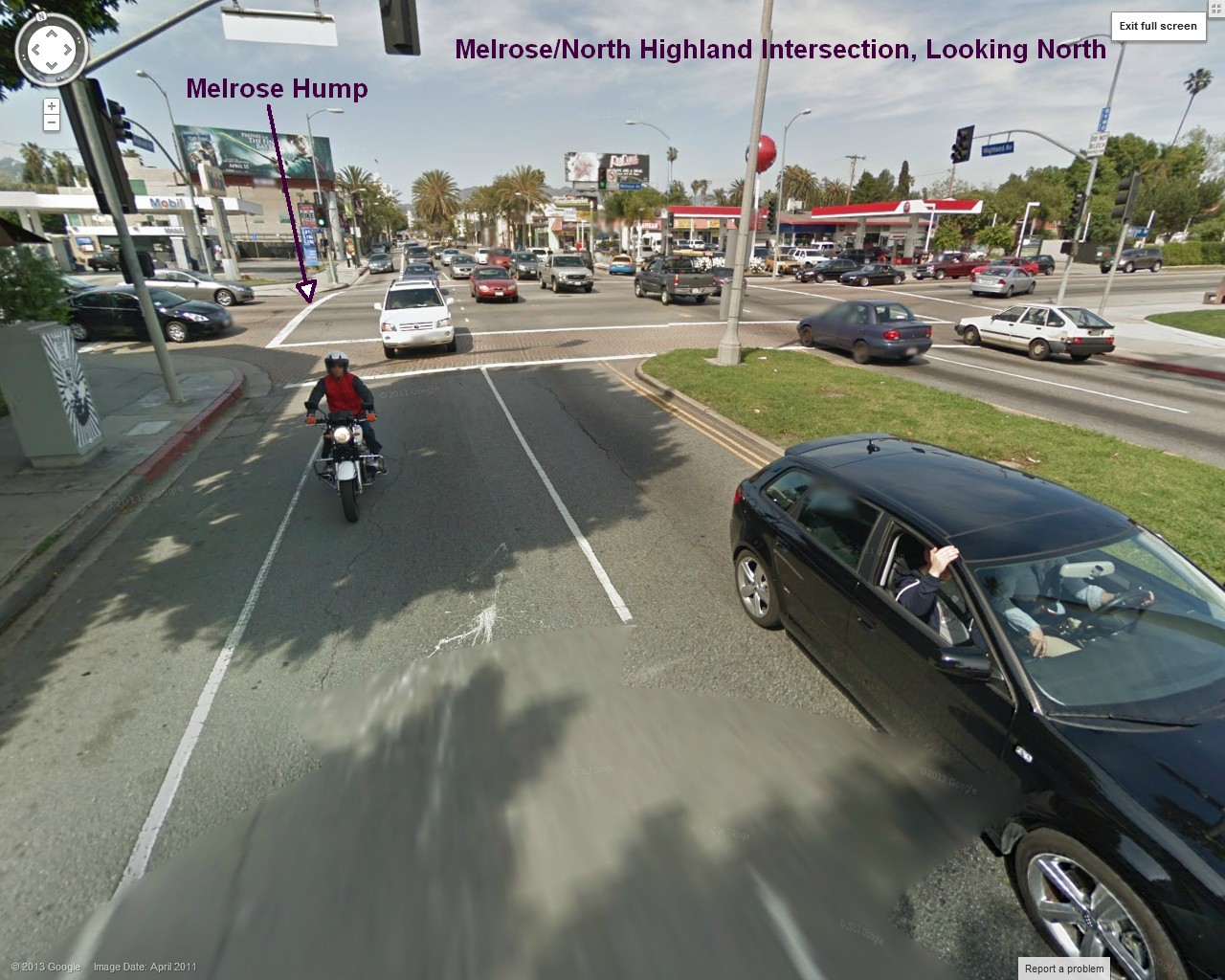
Krikorian also mentions a "metal protrusion--perhaps 30 inches tall and 2 feet wide--that gives access to city water mains below." (Another witness calls this a "hydrant." See below.) I can't see the metal protrusion on the Youtube video, but maybe Krikorian has a higher fidelity version of the video.
The metal protrusion isn't visible in Google street view images captured April 2011. So the above-ground pipes must have been put in after that date. However, street view images do show above-ground water pipes near the Pizzeria Mozza (below, left) and in the 500 block of North Highland (below, right).
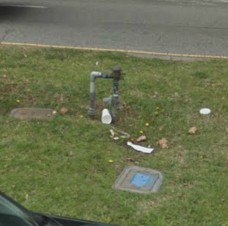
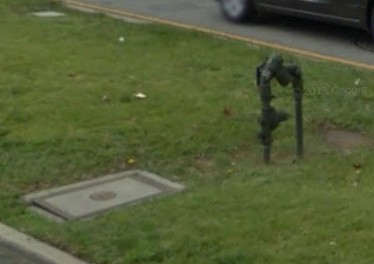
Evidently Michael Hastings ran over pipes like these before crashing into the tree. That would explain the gushing water seen in the LoudLabs videos. Also, it seems possible the pipes might have punctured the Mercedes fuel tank, contributing to or causing the fire.
Evidence: Eyewitness at Santa Monica Crossing
A witness named Michael Carter posted an account of the incident on Facebook. As reported by Yahoo News, he was "stopped at a red light tonight when a pearl white Mercedes flew past....It shook my car like a freight truck going by. Saw it burst into flames a quarter mile down the road when it hit a tree."
He goes on to give further details.
I was stopped at the light at Santa Monica [Boulevard], headed south on Highland [Avenue]. I looked down to turn my radio down, and this car just blasted past me through the red light--it shook my car. No telling how fast the driver was going. A taxi driver was in the far right lane and we looked at each other, both saying, "What the hell was that?"... By the time the light changed, I could only see the tail lights of the white Mercedes--it was probably past Willoughby by then which was the next red light that I got stopped at. The Mercedes was flying down Highland. The same cab driver pulled up to the light at Willoughby [Avenue] and I looked over at him again in disbelief. Right as I did, the cab driver said something to the effect of, "He didn't make it." The [Mercedes] was all the way south of Melrose [Avenue] at this point.
I looked down Highland and saw a giant fireball at the base of one of the palms that line the medians on Highland. It was surreal. Even from as far away as I was, I could see how violent an impact it had been. I live in the area so parked near my place and sprinted over the the scene of the accident. As I was running, a couple of workers from the service station at the corner of Melrose and Highland were also running over. In broken English, one of them and I traded stories of what we saw as we ran. From what I could understand, he saw the car come off the ground at some point--maybe when [it] crossed Melrose.
A Hancock Park resident was already spraying the car with his water hose when we got to it, but wasn't making any progress. The car was engulfed. I couldn't see inside it. Fire trucks and police cars were at the scene almost immediately, it seemed.
I stayed and watched firefighters extinguish the the blaze. Bummed a cigarette from a guy named Jeremy and traded stories about what we saw. He was right around Melrose and Highland when it happened. I gave a statement to police and walked home.
Evidence: Eyewitness Account at the Melrose Crossing
The Young Turks Network interviewed Jose Rubalcava, seen on the LoudLabs hand-held video, about the crash. A video of that interview is on Youtube. His Spanish language responses are translated to English in the captions. Here are his words.
Note that Jose Rubalcava says sparks and flames were coming from underneath Hastings' car before it hit the tree.I saw the car going full speed. He didn't slow down. So I ran to see because it seemed like he wanted to kill himself. I ran to the street and I asked myself, "how will this end?" When I said that, it's when he crashed into the palm tree.
The car was bouncing, flames and sparks near the gas tank. When he hit the palm tree, that's when the flames went higher. There were explosions and everything. The transmission was found a few feet in front of the car.
After the firefighters extinguished it, I approached the car. And I don't know if it was the jitters, but I saw him from the neck up. I didn't see his body.
[The reporter asks, "You saw the sparks prior to him hitting anything? You saw them at the bottom of the car?"]
Yes. Plenty from the beginning, way before he crossed the light.
[Q. "How fast would you say the car was going if you had to do an estimate?"]
I think he was going maximum speed on his speedometer. I think he was going the car's top speed. I think he came across deeper pot holes, and he fish-tailed and he went into the palm tree. And that's when he crashed.
[Q. "Did you see him lose control of the vehicle and at what point did he lose control?"]
As soon as he crossed the Melrose stop light about fifty feet ahead is when he lost control.
[Q. "Before he hit the tree, was there any dip in the road? Did you notice him hit a dip and that's when he lost control?"]
Yes, his car bounced three or four times. That's when he crashed into the palm tree.
[The reporter asks, "How long did it take for the police to show up on the scene?"]Three to four minutes. Five.
[Q. "Were there any other cars following him?"]No, I didn't see any. He was alone. I didn't see any cars. No one could approach the car because it kept exploding. And no none could get near until the firefighters got there. But even before the firefighters extinguished the flames, I think he had been dead on impact. He was going too fast. When he crossed Melrose it looked like he accelerated and lost control.
[Q. "How did you feel when you saw everything? You saw it from beginning to end. And what were your emotions after you saw it?"]I felt very nervous, very shaken. The day felt very long at work. When I got home I couldn't sleep.
Evidence: Eyewitness Account of the Removal of the Body
A woman in a second story bedroom overlooking the crash site was awakened by the boom and flash of the collision. She (called here "Mrs. A") and her husband immediately got out of bed to see what was happening and then continued to observe all activity there for the next three hours. She described what she saw in a telephone interview with Gigi Erneta of infowars.com. (See a transcript of that interview here.)
Mrs. A confirms what other witnesses have said.
1. She says, "The car was on fire simultaneously with the impact."
2. Fire trucks arrived on scene three or four minutes after the impact. The firemen extinguished the fire in thirty seconds after apparently concluding that Hastings was dead and there was nothing they could do to save him.
3. She mentions the above-ground pipes.
GE: I was there and I noticed there were no marks on the street itself. No marks on the curb. It was fascinating. There wasn't even a crack on the curb. The water pipes that were there before, those were broken. And I guess you could see where they had been severed.
Mrs. A: He knocked down the fire hydrant and the box. There was a metal box around it, standing about two feet up and that was completely mangled. And that frame was also on the corner of Clinton.
GE: And you say it was mangled?
Mrs. A: Completely. yeah. Like screwed to metal (?). It was like made the metal chain-link kind of thing and it was completely destroyed.
[Male voice]: Security box.
Mrs. A: Kind of like a security frame for that hydrant. So that was completely bent -- bent out of shape.
4. She speaks of what happened in the three hours after fire was put out.
The body was in the car for three hours. For those three hours a bunch of police cars and detectives and supervisors and the police were all around the block, measuring, taping, taking pictures, taking videos, a separate photographer from the police, taking pictures from all kinds of angles. There was a detective who was not in police uniform there supervising the whole thing. There was a supervisor in police uniform supervising the policemen.
5. She says debris was strewn from the vehicle all the way down to Clinton Street. Also, the police did not move any debris from the crash site for at least three hours after the crash.
(The picture below shows the debris in the northbound lane of North Highland as it appeared in the light of day.)
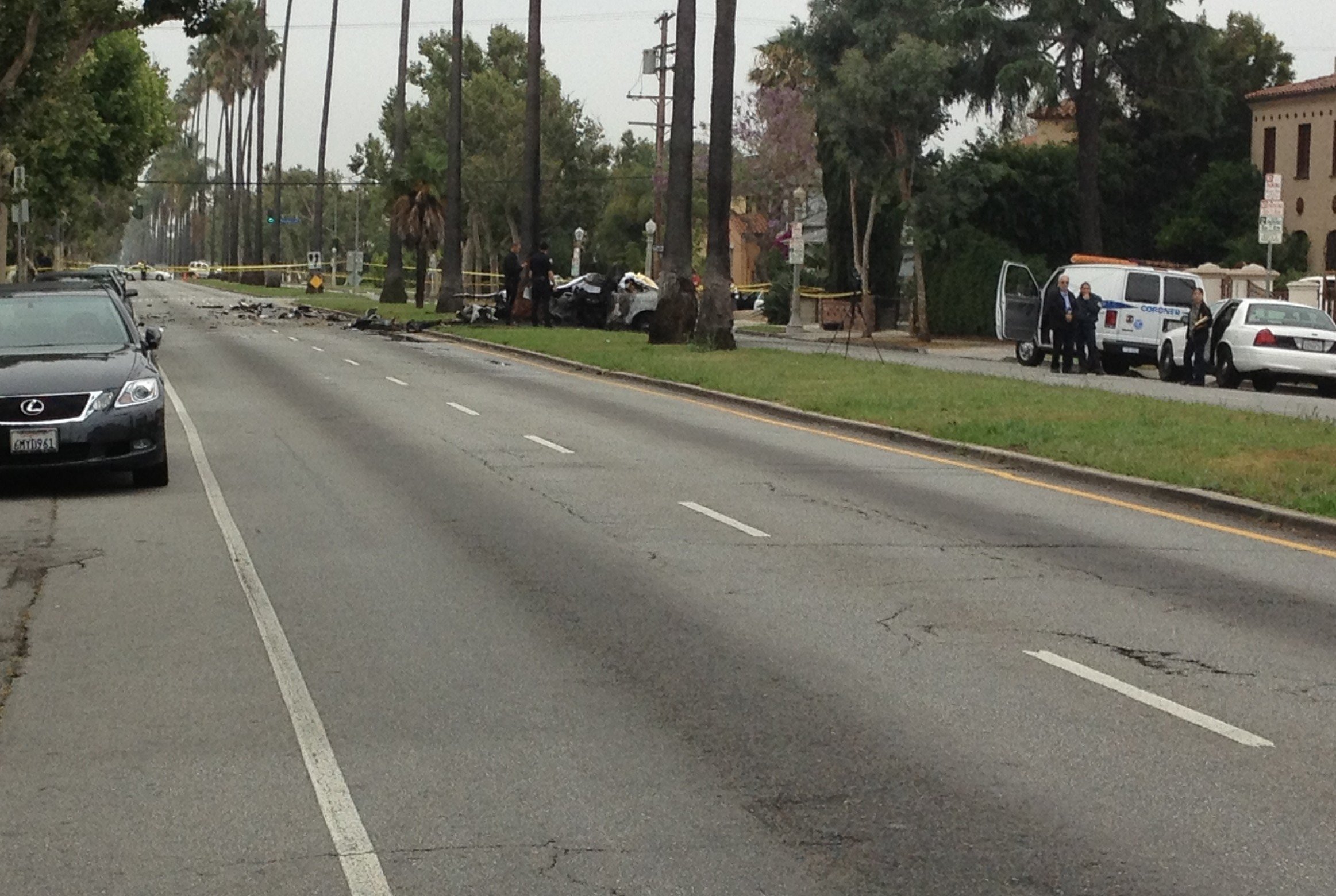
6. Eventually two coroners and a second crew of firemen arrive on the scene.
GE: So when they got the jaws of life out, they sawed in the door in the left side, the driver's side, but they didn't do anything else to the other side. Then they pulled it apart with the fire truck.
Mrs. A: They cut it apart. All the police pictures were taken before that.
GE: And then they got Hastings out of the car. Tell us a little about that.
Mrs. A: OK. So when I tell about that I have to preface it with the fact that they were trying their best not to let me see it. So whatever I did see, it was hard to see. What I expected to see -- after that fire -- basically was a body in pieces and completely black. So I saw his full body with a completely black face. Completely burned face up to the shoulders. From shoulders down I saw the whole body which was completely intact, not burned in any way. I didn't know who it was but when I saw it, I told my daughter it was white guy about 25 - 30, I told her. A white, young guy. And I'm still doubting I could see it, but how did I know it was a white guy 25 - 30 with completely white arms -- not burned in any way. And from what I saw he was wearing something like a T-shirt, but I saw the gray color, but it could have been gray from the smoke. I don't know what its (?) is. As far as I could see, it was cut-off sleeves. I saw full white arms. I even paid attention that it was -- I thought to my self: it is California and the guy is so white, so not-tanned. But it was a dead body.
GE: It was sevenish when all this happened?
Mrs. A: it was 7:20 to 7:40.
Analysis of the Impact
Here's an annotated aerial view showing the impact point of the crash and the location of engine/transmission after the crash.
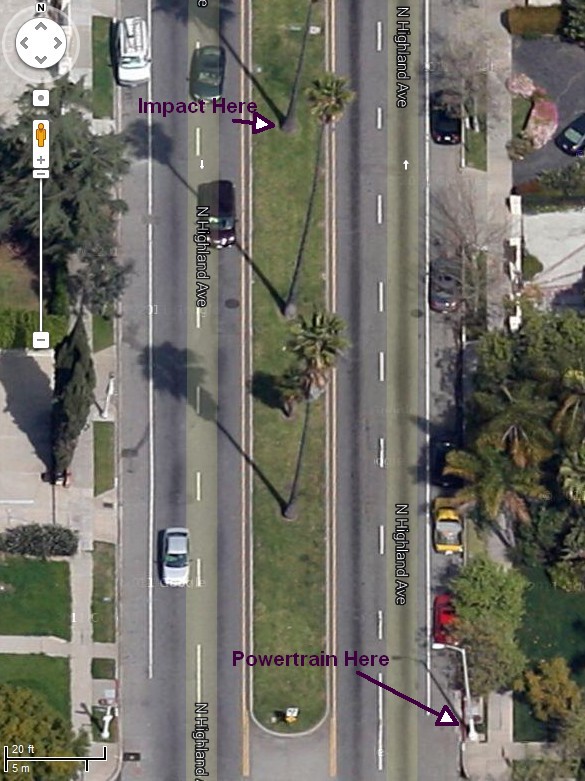
Using the scale in the Google aerial view image, the distance from the impact point to the powertrain resting point is 123 feet; and the distance from the center of the median strip to the powertrain to be 35 ft. If we assume that the powertrain traveled in the same direction as the car was going at the time of impact, then the car was traveling at a 16 degree angle (arcsin(35/123)) with respect to North Highland Avenue.
From the LoudLabs handheld video (discussed above) it's clear that the Mercedes struck the tree on the driver's side, directly in front of the driver, maybe a little to the driver's left. This type of impact would leave room for the engine/transmission to fly in the direction of the vehicle's momentum at the instant the engine broke loose. We conclude the vehicle was traveling at a 16 degree angle with respect North Highland Avenue at that time. Also, note that a driver-side impact would cause the car to pivot about the tree in a counter-clockwise direction (seen from above), which is what seems to have happened. See the diagram below for illustration.
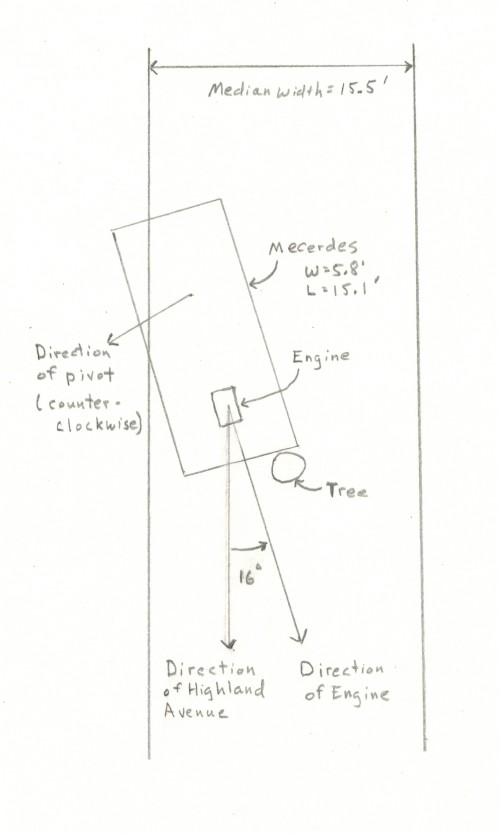
Open Questions
1. How many airbags deployed? Is it possible that air bags deployed before the car hit the tree?
2. What's the cause of the popping sounds coming from the burning car in the LoudLabs handheld camera video?
Loose bullets inside the vehicle?
3. What's the explanation for the explosion and raging fire in the Michael Hastings' crash? Fires are rare in single-car collisions. And when they do occur, they start slowly.
The Hollywood Reporter questioned several experts about the suspicious fire that burned Hastings' car. One said:
I've seen dozens of cars hit walls and stuff at high speeds and the number of them that I have observed to eject their power trains and immediately catch massive fire is, um, ah, zero. Modern cars are very good at not catching fire in accidents.
Frank Markus of Motor Trend said:
[A]ny impact at speeds high enough to rip the drive train out of a car is highly likely to force some object to rupture the fuel tank. There is a lot of potential chemical energy in a gas tank that's even a quarter full. Getting up to such speeds -- providing he didn't start a cold engine and floor the car into that tree -- results in a lot of red hot parts, particularly the catalytic converter and other exhaust system parts.
Comment: In this incident the powertrain flew forward, away from the fuel tank. The effect, if any, would be to pull the exhaust system parts forward along with it. That is to say, they wouldn't be forced backward or upward into the fuel tank.
Max Kennerly, a Philadelphia attorney said:A car's interior is particularly flammable.
Your car is filled with fabric, foam and plastic, but the only federal standards relate to dropping a cigarette on it. What happens in these higher-speed accidents is that hot parts leave the engine compartment and start coming into contact with plastic and other chemicals. The last time NTSB did testing on this, those fires spread in one to three minutes. That nice interior with shiny leather and chemicals that make it look and smell nice, all of it will catch fire. Once something like foam or plastic reaches the temperature of burning, it burns immediately. It looks like a bomb -- it looks like an incendiary was planted on [Hastings' car] because many times it produces the same types of chemicals as it degrades.
Comment: He says, "What happens in these higher-speed accidents is that hot parts leave the engine compartment and start coming into contact with plastic and other chemicals." That's not what happened in this case. The hot engine flew forward, not backward into the car's passenger compartment with all the flammable plastics. Also, video of the fire four minutes after impact shows the biggest part of the fire to be at the rear, where the gas tank is. Looks more like the fire started at the fuel tank and spread from there to the flammable plastics inside.
There's suspicion that the fire was started by an incendiary device triggered by shock or airbag deployment. The incendiary device would be more like a firecracker than a bomb. Its purpose would be explode the gas tank.
4. Would it be possible to detect if the electronic controls of Hastings' burned-up car had been hacked?
In my opinion, it would be very difficult for forensic experts, even if they had hands-on access to the wrecked vehicle, to detect the hacking.